Cleaning
1. For a complete cleaning, remove the coolant pump, all external components, and all electrical switches and sensors. Turn out the nozzles for spraying oil on the pistons or plugs installed in their place. Please note that when performing a complete engine disassembly, always replace the oil spray nozzles on the pistons (if available) (see fig. 12.1, a-g).
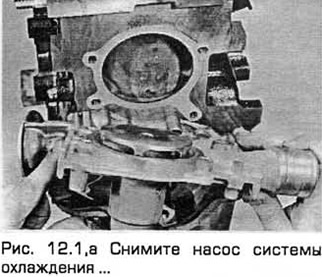
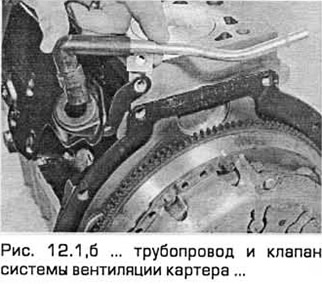
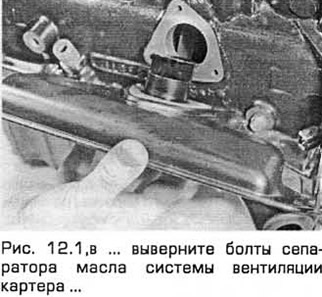
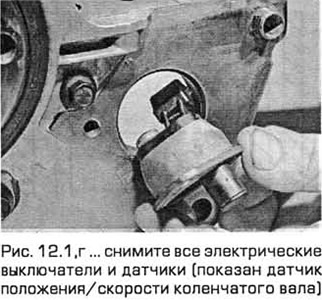


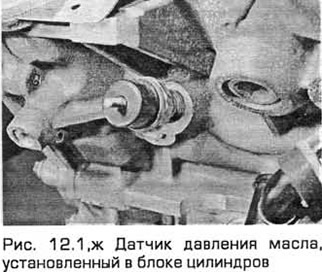
2. Remove the main bearing caps and separate the liners from the caps and from the cylinder block/crankcase. Label the liners so you know which cover or location in the cylinder block they came from, then fold them in (see fig. 12.2). Wipe the bushings in the block and in the covers and inspect them for scratches and nicks.

3. Scrape off the remnants of the old gasket from the cylinder block / crankcase, but so as not to damage the sealing surfaces.
4. Remove all oil channel plugs (in the presence of). Usually they are tight. Therefore, they can be drilled and new threads cut into the holes. When assembling the engine, use new plugs. Also remove the technological plugs from the walls of the cylinder block. Try knocking them out with a hammer, striking through the beard on the side of the plug, trying to turn it around in the hole. If you succeeded, grasp the end cap with large pliers and pull it out of the hole. Alternatively, drill a hole in the center of the plug and remove it with a puller (for body work), (see fig. 12.4).
Keep in mind: If a technological plug is driven into a hole, then it will be very difficult, and often impossible, to pull it out.
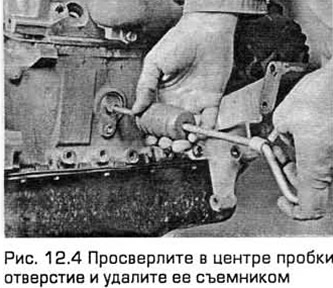
5. If the cast surfaces are heavily soiled, they must be cleaned with steam.
6. Clean all oil passages and holes again after steaming. Rinse all internal channels with hot water until then. until the water is clear. Dry thoroughly and apply a light coat of lubricant to all mating surfaces to prevent corrosion. Lubricate the cylinder mirrors. If compressed air is available, use it to speed up drying and blow out oil passages and holes.
Warning: Protect your eyes when using compressed air!
7. If the cast surfaces are lightly soiled, they can be cleaned with a solution of soap in hot water and a stiff brush. The water should be as hot as possible. Take enough time to do this job carefully. Regardless of the cleaning method, carefully check the cleanliness of all oil channels and holes and thoroughly dry all parts and assemblies. Protect the cylinder bores from corrosion as above.
8. All threaded holes must be cleaned to ensure the specified tightening torques during assembly. To do this, run the threads with a tap to remove rust, grease or dirt, and to repair damaged threads (see fig. 12.8). If possible, blow holes with compressed air.
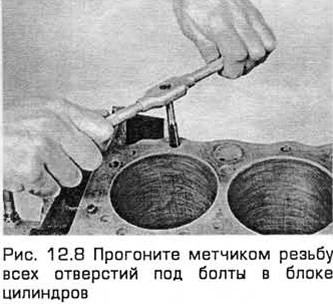
9. Apply sealant to the seating surfaces of the cooling jacket plugs and install them in the cylinder block. Ensure that they are installed correctly without distortion, otherwise leaks may occur. Apply sealant to the new oil passage plugs and insert them into the cylinder block bores. Tighten plugs securely (see fig. 12.9).
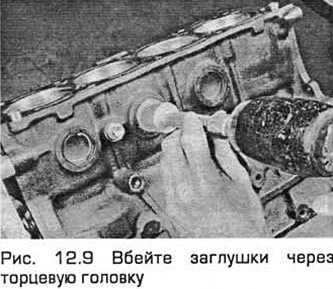
10. Install plugs or (new) nozzles for spraying oil on the piston bottoms. Tighten them to the required torque (see fig. 12.10). install also all other external components that were removed. Install the main bearing caps (4-cylinder engines) or lower crankcase (V-shaped 6-cylinder engines) and tighten them by hand.
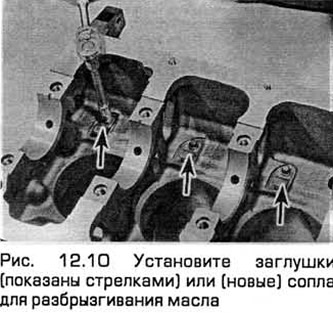
11. If you are not going to assemble immediately, cover the engine with a large plastic bag to protect the engine from dirt. Protect mating surfaces from corrosion by lubricating them with engine oil.
Control
12. Check cast surfaces for corrosion and cracks. Inspect threaded holes for damaged threads. In the event that water leaks are found inside the engine, contact a specialist to check the cylinder block / crankcase using special equipment. If defects are found, it is necessary to repair or replace the cylinder block / crankcase (see fig. 12.12).
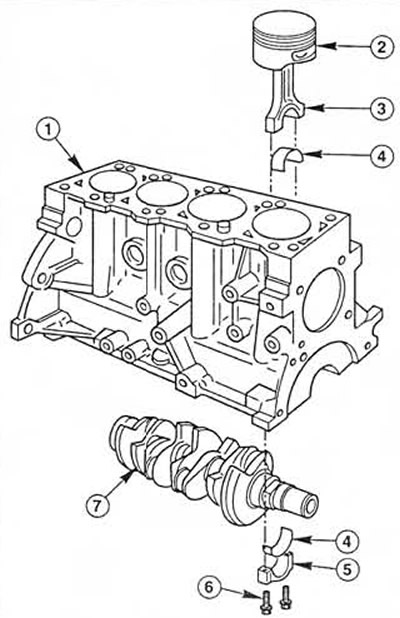 Pic. 12.12 Cylinder block, connecting rod with piston and crankshaft parts (4-cylinder engines)
Pic. 12.12 Cylinder block, connecting rod with piston and crankshaft parts (4-cylinder engines)
1. Cylinder block/crankcase
2. Piston
3. Connecting rod
4. Connecting rod bearing
5. Connecting rod bearing cap
6. Connecting rod bearing cap bolts
7. Crankshaft
13. Examine the surfaces of all cylinders for scratches and scuffs.
14. All main bearing cap bolts (4 cylinder engines) or lower crankcase (V-shaped 6-cylinder engines) it is necessary to tighten the required torque, provided that the crankshaft and liners are missing. Measure the diameters of all cylinders in a direction parallel to the axis of the crankshaft: at the top of the cylinder (directly under the ledge), central, and also at the bottom of the cylinder. After that, measure the diameters of the cylinders in the direction perpendicular to the axis of the crankshaft in the same sections (see fig. 12.14, a-c). Record the measurement results.
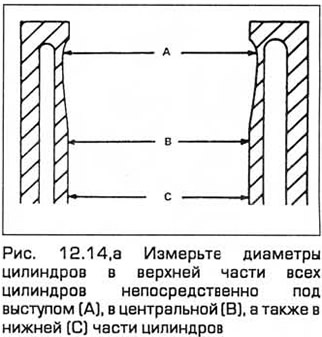
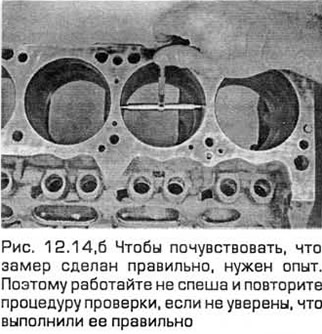
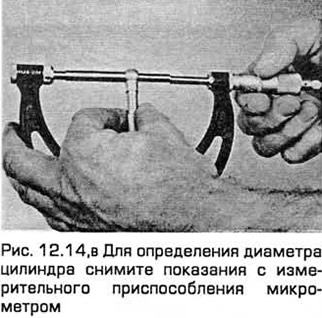
15. Measure the diameter of the piston in a direction perpendicular to its finger, in the section directly above the bottom edge of the skirt. Record measurement results (see fig. 12.15).

16. If you want to determine the clearance between the piston and the cylinder, measure the cylinder and piston skirt diameters as above and subtract the skirt diameter from the cylinder diameter. If you do not have accurate measuring tools, then the condition of the pistons and cylinders can be checked, but with less accuracy, using probes as follows. Choose a feeler gauge with a thickness equal to the regulated clearance between the piston and the cylinder, and insert it into the 8th cylinder together with the corresponding piston. The piston must be installed in its working position. And the probe must be inserted from one side of the cylinder, experiencing axial force (at right angles to the piston pin). The piston must slide on the cylinder (relative to the fixed probe) with little effort. If it slides without resistance at all, the gap is too large and a new piston needs to be installed. If the piston sticks on the lower edge of the cylinder, and at the top it moves freely, then the cylinder has a taper. If, when turning inside the piston cylinder, together with the probe, you feel areas of sticking, it means that the cylinder has a non-circularity (ovality).
17. Repeat these procedures for the remaining pistons and cylinders.
18. Compare the results with the Specifications. If any of the measurements deviate from the allowable (for this class - see the marking on the piston crown), or if the cylinder diameters are significantly different from each other (which indicates taper or ovality), means the piston or cylinder has excessive wear.
19. Worn pistons should be replaced. At the time of writing this book, the pistons were not supplied separately, but only as part of a connecting rod and piston group. Check with dealers for the latest information.
20. If one of the cylinders has deep scores or scratches or is excessively worn or has a large ovality or taper, then proceed in the usual way. That is, they regrind the cylinder block / crankcase and install new oversized pistons.
21. If the cylinders are in good condition and not worn out, then only the piston rings can be replaced.
22. In this case, and if new piston rings are present, the cylinders must be honed to ensure that the new piston rings run in properly and provide a good seal. Install the main bearing caps before honing the cylinders (without inserting inserts) and tighten the bolts to the required torque.
Note: If you do not have special tools or do not want to do honing, this operation can be performed by engine repair specialists for a small fee.
23. There are two types of hones for processing cylinders - flexible hon or type hon "bottle brush" and the more familiar khon with spring-loaded stones. Both types of hone are suitable for this job and are usually mounted on an electric drill. For a less experienced car owner, it is more convenient to use "bottle brush". You will also need some kerosene or honing oil. as well as rags. Follow these instructions:
- A) Insert the te hon into the hole, squeeze the stones and pull it in (see fig. 18.S3,a). Wear safety goggles or a visor!
- b) Lubricate the hole with honing oil. Turn on the electric drill and stir the hone up and down the hole so that you get a mesh surface on the walls of the cylinder. Ideally the grid lines should intersect at an 80°angle (see fig. 13.23.6). Do not use too much lubricant.
Note: Piston ring manufacturers may specify the angle of intersection of the lines when honed. Read the instructions for the rings carefully.
- V) Do not pull the hone out of the hole while it is spinning, but instead turn off the drill and continue moving the hone up and down the hole until it comes to a complete stop. Then squeeze the stones and pull out the hon. If you are working "bottle brush", turn off the drill, then, turning the drill chuck in the direction of its working rotation, pull the hone out of the hole.
- G) Wipe the cylinder to remove oil and repeat the procedure for the rest of the cylinders.
- d) After honing all cylinders, chamfer the edges of the holes with a fine file so that the rings do not stick when the pistons are installed. Be careful not to nick the cylinder walls.
- e) The cylinder block/crankcase must be washed completely with warm soapy water to remove dirt after honing.
Note: Cylinders are clean when you press a white, lint-free cloth soaked in clean engine oil against the cylinder walls and rub them, and then you don't find honing particles that show up as gray spots on the cloth. Clean all oil passages with a brush and flush them with a stream of water.
- and) After cleaning the cylinder block/crankcase, dry it and then lightly grease all machined surfaces to prevent rust.
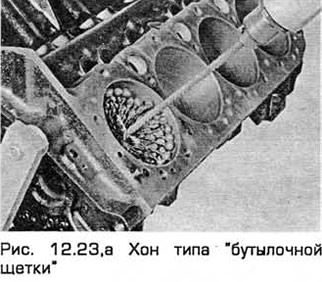

24. The cylinder block/crankcase is now completely clean and dry and all components checked for wear or damage and repaired if necessary. Install as many accessories as possible. If you are not reassembling the engine right away, cover the block with a large plastic bag to keep it clean and prevent the machined surfaces from rusting.
If you do not have a piston ring extractor, you can remove them by hand. Gently spread the ends of the rings over the surface of the piston head. Use 2-3 used feeler gauges to prevent rings from falling into empty grooves.
Visitor comments